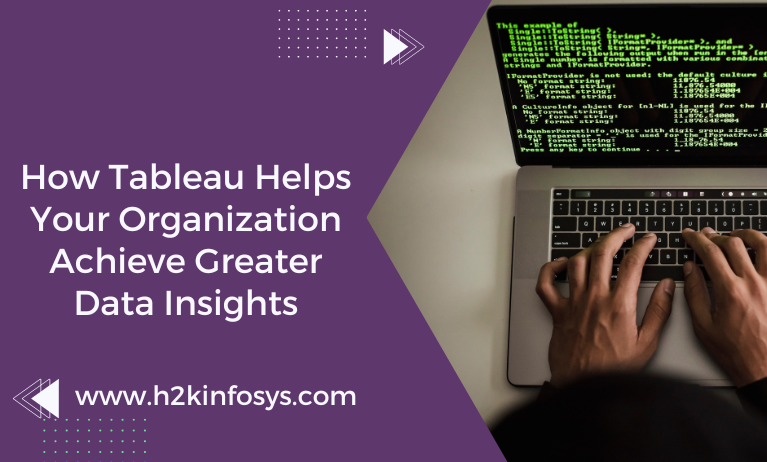To survive and prosper in a world that is becoming more and more hyper connected and digitised, the majority of enterprises have started digital and data transformation Tableau initiatives. As a result, businesses are increasingly producing vast amounts of data that they may utilise to improve their decisions. Analysts must be equipped with the greatest business intelligence tools to extract priceless insights for data-driven decision-making in order to maximise the return on data.
Business intelligence (BI) tools: what are they?
Business intelligence (BI) is a collection of skills and tools that turns data into useful insights so that organisations can make more informed decisions. Business intelligence is provided via BI tools, which give analysts access to an easy drag-and-drop interface to carry out tasks like:
- Data preparation: assembling and structuring data from many sources for analysis.
- Data Querying: Data querying is the process of extracting answers from datasets to address certain data queries.
- Data Visualization: Making charts, graphs, histograms, and other visual representations of analyses for ease of comprehension is known as data visualisation.
- Performance Metrics reporting: Reporting on performance metrics involves comparing current performance to historical data and sharing the results with decision-making stakeholders.
- Data Mining: Data mining is the process of finding patterns in large datasets using statistics and machine learning.
Use of BI tools in the industry
Since the 1960s, there has been a BI theory. It comes as no surprise that there are currently hundreds of reliable BI solutions on the market that can assist businesses in utilising data for business analytics. Microsoft’s PowerBI and Tableau are the two most widely used BI products.
Modern BI systems are most valuable when they provide self-service analytics, quick time to insight, and an intuitive user interface. Modern BI solutions enable staff to access data rapidly and provide independent answers to business problems rather than the traditional method of submitting requests to a central data team.
Here are some instances of BI applications in business:
- Volvo Group used Qlik to increase the effectiveness of reporting important financial results, which enabled embedded, independent decision-making across the company.
- As part of the medical centre’s data-driven operational response to the COVID-19 epidemic, UChicago Medicine used Tableau to provide real-time dashboards.
- Zurich Insurance Group used Power BI to create a unified platform for business users to better effectively mine and utilise company data.
In order to stay up with the quick changes in the market and optimise procedures for business success, JPMorgan Chase selected Tableau as a self-service analytics tool controlled by the business rather than the IT department.
Tableau is a business intelligence (BI) and data visualisation platform that uses visual analytics to help individuals and companies make the most of their data. Stakeholders are able to make sense of the enormous volumes of data available thanks to the captivating visualisations produced by Tableau.
Tableau, a project that began at Stanford in 2003, attempts to increase data accessibility for users through visualisation. It is now the market leader for contemporary BI and is utilised by businesses across all sectors.
The most well-known BI tool on the market is probably Tableau. Tableau, among BI technologies, has the highest market share (16.3%), according to Enlyft. You can learn more about Tableau by checking the Tableau training online.
How is Tableau useful?
1.Extract data insights with no coding skills required
Tableau’s user-friendly interface, which enables both technical and non-technical analysts to easily produce data visualisations and analyses, is one of its key advantages.
Without the requirement for programming knowledge, complicated data-related queries can be answered using the user-friendly drag-and-drop interface. Users are more likely to execute advanced analytics, such as trend analysis, regressions, and statistical summaries, because of this simplicity.
For analysts looking to validate and demonstrate their proficiency in product knowledge and data visualisation skills, Tableau also provides a range of certifications. Since these qualifications are very applicable in any business or job, it is helpful in assisting analysts in becoming competent data practitioners.
2.Democratise data insights with dashboards
The dashboard is a well-known classic BI application where data is gathered from many sources and visually presented in charts and graphs to give an understanding of the business’s activities and strategies.
Tableau offers a variety of workbook capabilities that enable users to quickly create attractive interactive dashboards. Additionally, it has the ability to link to a variety of data sources, including SQL Server, Excel spreadsheets, Amazon Redshift, etc. These dashboards can then be enhanced with thorough data from other applications used throughout the enterprise.
These dashboards significantly contribute to the strategic alignment of an organisation’s efforts, the discovery of crucial insights, and the acceleration of enterprise-wide decision-making. Data insights can be democratised at scale to help with decisions when numerous individuals are taught to build such dashboards. It also helps to transform the business into a data-driven company.
3.Tell data stories with advanced data visualisation
Given the enormous volumes of data being generated in the digital age, compelling data storytelling is more crucial than ever.
Dashboards are excellent for tracking data and updating users on what’s going on. Data stories, on the other hand, assist in transforming the data into a step-by-step narrative to explain why particular trends are occurring.
Users of Tableau can combine several visualisations, including dashboards, to create a visual story that explains data insights, provides context, and illustrates how decisions affect outcomes. What distinguishes Tableau from other programs like Excel is its capacity to integrate sophisticated visualisations (such as geolocation mapping) into a compelling data story. These data tales are very good at framing a convincing argument to convey useful information to decision-makers, which is in line with the primary goal of business intelligence.
Conclusion Tableau is a great tool that organisations use to achieve great data insights. To learn more about how Tableau works, you can check out the online Tableau training.



























